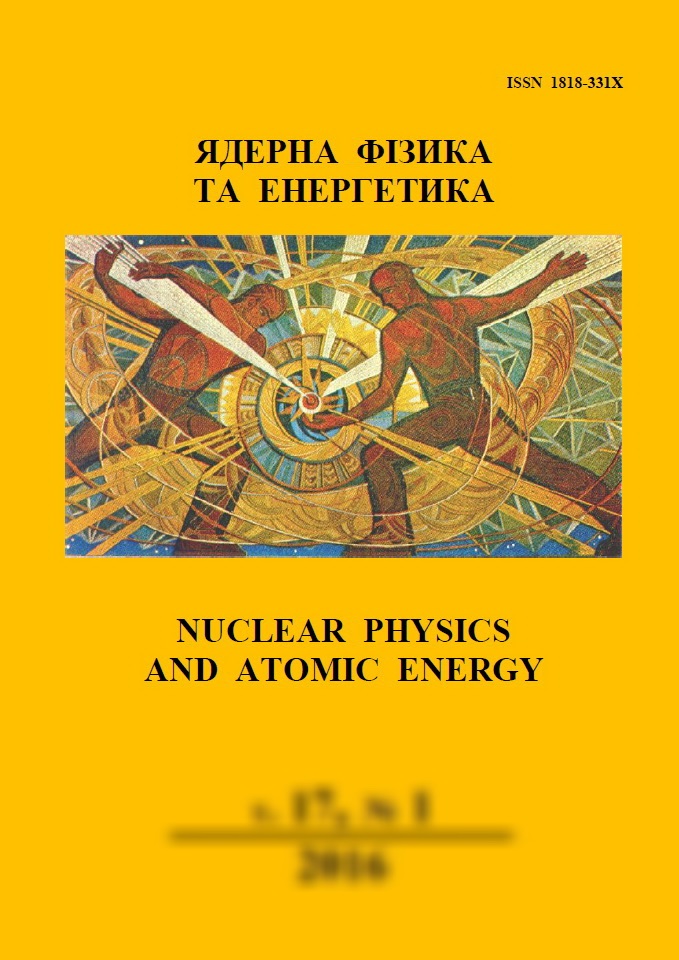 |
ядерна ф≥зика та енергетика
Nuclear Physics and Atomic Energy
ISSN:
1818-331X (Print), 2074-0565 (Online)
Publisher:
Institute for Nuclear Research of the National Academy of Sciences of Ukraine
Languages:
Ukrainian, English
Periodicity:
4 times per year
Open access peer reviewed journal
|
Nucl. Phys. At. Energy 2010, volume 11, issue 3, pages 269-274.
Section: Nuclear Physics.
Received: 28.04.2010; Published online: 30.09.2010.
 Full text (en)
Full text (en)
https://doi.org/10.15407/jnpae2010.03.269
Fluctuations in initial energy density distributions in A + A collisions
M. S. Borysova1, Yu. O. Karpenko2, Yu. M. Sinyukov2
1Institute for Nuclear Research, National Academy of Sciences of Ukraine, Kyiv, Ukraine
2M. M. Bogolyubov Institute for Theoretical Physics, National Academy of Sciences of Ukraine, Kyiv, Ukraine
Abstract:
The analysis of particle correlations as a function of relative pseudo-rapidity and azimuthal angle exhibit novel
ridge-like structures that were discovered at RHIC in A + A collisions. Such an analysis is of great interest for forthcoming ALICE LHC experiment. This structure which is unusually wide in the longitudinal direction remains after
removal of the known correlation-inducing effects such as elliptic flow and ordinary jet correlations. It could be probably explained only if one supposes that the ridge phenomenon in relativistic A + A collisions is rooted in the initial
conditions of the thermal evolution of the system. The aim of this study is to check this hypothesis by an analysis of the
evolution of the energy density in the system which at very initial stage of collisions has high density tube-like fluctuations with boost-invariant longitudinally homogeneous structure within some space-rapidity region. The transverse-velocity and energy density profiles, which develop in the system when it reaches the chemical freeze-out
(T = 165 MeV) for different initial configurations at τ0 = 0.2 fm/c, are considered.
Keywords:
nucleus-nucleus collisions, hydrodynamics, ridge, fluctuations.
References:
1. Horner M. G. Low- and intermediate-pT di-hadron distributions in Au + Au collisions at sqrt(sNN) = 200 GeV from STAR. J. Phys.
G: Nucl. Part. Phys. 34 (2007) S995.
https://doi.org/10.1088/0954-3899/34/8/S142
2. Gavin S., McLerran L., Moschelli G. Long range correlations and the soft ridge in relativistic nuclear collisions. Phys. Rev. C 79 (2009) 051902(R); arXiv:0806.4718 [nucl-th].
https://doi.org/10.1103/PhysRevC.79.051902
3. Abelev B. I., Aggarwal M. M., Ahammed Z. Long range rapidity correlations and
jet production in high energy nuclear collisions. Phys. Rev. C 80 (2009) 064912; arXiv:0909.0191 [nucl-ex].
https://doi.org/10.1103/PhysRevC.80.064912
4. Adare A., Afanasiev S., Aidala C. et al. Dihadron azimuthal correlations in
Au + Au collisions at sqrt(sNN) = 200 GeV. Phys.
Rev. C 78 (2008) 014901;
arXiv:0801.4545 [nucl-ex].
https://doi.org/10.1103/PhysRevC.78.014901
5. Wosiek B. Latest results
from the PHOBOS experiment. J. Phys. G 35 (2008) 104005.
https://doi.org/10.1088/0954-3899/35/10/104005
6. Armesto N., Salgado C. A., Wiedemann U. A. et al.
Measuring the Collective Flow with Jets. Phys.
Rev. Lett. 93 (2004) 242301; arXiv: hepph/0405301.
https://doi.org/10.1103/PhysRevLett.93.242301
7. Romatschke P. Momentum Broadening in an Anisotropic Plasma. Phys. Rev. C 75 (2007) 014901; arXiv: hep-ph/0607327.
https://doi.org/10.1103/PhysRevC.75.014901
8. Majumder A., Muller B., Bass S. A. Longitudinal
Broadening of Quenched Jets in Turbulent Color
Fields. Phys. Rev. Let. 99 (2007) 042301; arXiv: hep-ph/0611135.
https://doi.org/10.1103/PhysRevLett.99.042301
9. Wong C. Y. Ridge structure in the (Δφ)-(Δη) correlation function associated with a near-side jet.
Phys. Rev. C 76 (2007) 054908; arXiv: 0707.2385.
https://doi.org/10.1103/PhysRevC.76.054908
10. Chiu C. B., Hwa R. C. Pedestal and Peak Structure in
Jet Correlation. Phys. Rev. C 72 (2005) 034903; arXiv nucl-th/0505014.
https://doi.org/10.1103/PhysRevC.72.034903
11. Voloshin S. A. Transverse radial expansion in nuclear
collisions and two particle correlations. Phys. Lett. B 632 (2006) 490; arXiv: nucl-th/0312065.
https://doi.org/10.1016/j.physletb.2005.11.024
12. Shuryak E. V. On the Origin of the "Ridge" phenomenon induced by Jets in Heavy Ion Collisions. Phys.
Rev. C 76 (2007) 047901;
arXiv: 0706.3531.
https://doi.org/10.1103/PhysRevC.76.047901
13. Schenke B., Dumitru A., Nara Y. et al. QGP collective
effects and jet transport. J. Phys. G: Nucl. Part. Phys. 35 (2008) 104109.
https://doi.org/10.1088/0954-3899/35/10/104109
14. Dumitru A., Gelis F., McLerran L., Venugopalan R.
Glasma flux tubes and the near side ridge phenomenon at RHIC. Nucl. Phys. A 810 (2008) 91.
https://doi.org/10.1016/j.nuclphysa.2008.06.012
15. Kirshner R. P. The Extravagant Universe: Exploding
Stars, Dark Energy and the Accelerating Cosmos (Princeton University Press, 2002) 282 p.
16. Akkelin S. V., Hama Y., Karpenko Iu., Sinyukov Yu. M.
Hydro-kinetic approach to relativistic heavy ion collisions. Phys. Rev. C 78 (2008) 034906.
https://doi.org/10.1103/PhysRevC.78.034906
17. Sinyukov Yu. M., Karpenko Iu. A., Nazarenko A. V.
Spacetime scales and initial conditions in relativistic
A + A collisions. J. Phys. G: Nucl. Part. Phys. 35 (2008) 104071.
https://doi.org/10.1088/0954-3899/35/10/104071
18. Sinyukov Yu. M., Akkelin S. V., Hama Y. Freeze-Out
Problem in Hydrokinetic Approach to A + A Collisions. Phys. Rev. Lett. 89 (2002) 052301.
https://doi.org/10.1103/PhysRevLett.89.052301
